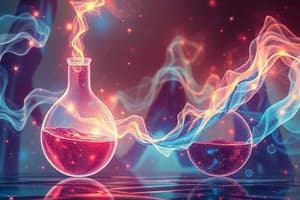Podcast
Questions and Answers
What does the equilibrium constant, $K$, express?
What does the equilibrium constant, $K$, express?
- The relationship between concentrations or partial pressures of reactants and products at equilibrium (correct)
- The rate of the forward reaction
- The temperature effect on equilibrium
- The Le Chatelier's principle
According to Le Chatelier's principle, if a system at equilibrium is disturbed, how will the system respond?
According to Le Chatelier's principle, if a system at equilibrium is disturbed, how will the system respond?
- By stopping the reaction
- By increasing the rate of the reverse reaction
- By adjusting itself to counteract the change (correct)
- By shifting towards the reactants
How does increasing temperature generally affect the equilibrium position?
How does increasing temperature generally affect the equilibrium position?
- Shifts towards the reactants
- Shifts towards the products (correct)
- Halts the reaction
- No effect on equilibrium
In which direction does an increase in pressure favor the reaction, according to Le Chatelier's principle?
In which direction does an increase in pressure favor the reaction, according to Le Chatelier's principle?
What is the main outcome of a disturbance to a system at equilibrium?
What is the main outcome of a disturbance to a system at equilibrium?
How does a larger equilibrium constant ($K$) impact the direction of a reaction?
How does a larger equilibrium constant ($K$) impact the direction of a reaction?
Which principle enables us to predict the direction of an equilibrium shift when disturbances occur?
Which principle enables us to predict the direction of an equilibrium shift when disturbances occur?
What effect does increasing pressure have on a system at equilibrium with multiple gas-phase reactants and products?
What effect does increasing pressure have on a system at equilibrium with multiple gas-phase reactants and products?
What will happen if a disturbance affects a system at equilibrium?
What will happen if a disturbance affects a system at equilibrium?
How does a higher temperature generally influence the position of an equilibrium?
How does a higher temperature generally influence the position of an equilibrium?
Flashcards are hidden until you start studying
Study Notes
Chemical Equilibrium: A Primer
Chemical equilibrium is a dynamic balance where a reaction occurs at equal rates in both the forward and reverse directions. At this point, the concentrations of reactants and products remain constant. This equilibrium can be described and quantified using several key concepts.
Equilibrium Constants
The equilibrium constant, (K), expresses the relationship between concentrations or partial pressures of reactants and products at equilibrium. A larger (K) indicates that the reaction will proceed to the right, favoring products.
Le Chatelier's Principle
Le Chatelier's principle states that when a system at equilibrium is disturbed, the system will adjust itself to counteract the change. This principle helps us understand how temperature, pressure, and concentration alterations affect the equilibrium composition.
Equilibrium Shifts
Disturbances to a system at equilibrium, such as changing temperature, pressure, or concentration of reactants and products, will shift the equilibrium position. Le Chatelier's principle enables us to predict the direction of the shift.
Factors Affecting Equilibrium
Temperature
Increasing temperature generally increases the rate of the forward reaction, leading to a shift in favor of the products.
Pressure
Increasing pressure favors the side with fewer moles of gas, according to Le Chatelier's principle.
Concentration
Changing the concentration of reactants or products can alter the equilibrium position, as described by Le Chatelier's principle.
Reaction Quotient
The reaction quotient ((Q) or (Q_p)) is a ratio of the concentrations of products to reactants at any time, not necessarily at equilibrium. If (Q = K), then the system is at equilibrium.
In summary, chemical equilibrium is an essential concept in chemistry that helps us understand and predict how chemical reactions proceed. By harnessing the concepts of equilibrium constants, Le Chatelier's principle, equilibrium shifts, and reaction quotients, we can uncover the complex relationship between reactants and products.
Studying That Suits You
Use AI to generate personalized quizzes and flashcards to suit your learning preferences.




